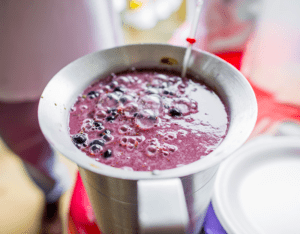 Hi:
Hi:
I made 5 gallons of Sauvignon Blanc this past year. I will be ready to bottle in the near future. I read on most commercial wine bottles that they contain sulfites. My understanding this is a stabilizer and to protect the wine yeast from refermentation. I am in the process of sending an order in and would like to know what to use and what amt. per gallon?
Thanks TOM
—–
Hello Tom,
Sulfites are added to a wine just before bottling, primarily to help eliminate spoilage and keep the wine’s color from turning through a process of oxidation. It does this by killing any traces of wild mold or bacteria that may have found its way to the wine and by driving the oxygen out of the wine.
Sulfites are not affective in squashing a refermentation, particularly if you have added an actual wine yeast to the wine as opposed to relying on wild yeast from the grapes to do the job. Domesticated wine yeast is somewhat resilient to sulfites, while wild yeast can be easily destroyed by it.
If you are concerned with the possibility of a refermentation occurring, you will also want to add potassium sorbate in addition to the sulfites, however this should only be necessary if the wine yeast did not completely ferment all the sugars in the wine must, or if sugar has been added back to the wine before bottling as a means of sweetening it.
The easiest way to add sulfites to your wine is to use sodium metabisulfite. We offer it as a granulated powder. You simply dissolve it into the wine right before you bottle. Make sure that the sodium metabisulfite gets evenly disbursed throughout the entire batch. A good way to go about this is to add the sodium metabisulfite to quart or so of the wine first, to dissolve it. Then blend the mixture into the rest of the batch.
The dosage of sodium metabisulfite you need is very small. You use 1/16 of a teaspoon for each gallon of wine. If you don’t have a 1/16 teaspoon, then use 1/8 teaspoon for each 2 gallons of wine. This is the same way wineries go about getting sulfites in the wine.
Happy Wine Making,
Customer Service at E. C. Kraus
———————————————————————————————————
Ed Kraus is a 3rd generation home brewer/winemaker and has been an owner of E. C. Kraus since 1999. He has been helping individuals make better wine and beer for over 25 years.
Category Archives: Q&A
My Wine's About Done, But Tastes Terrible!
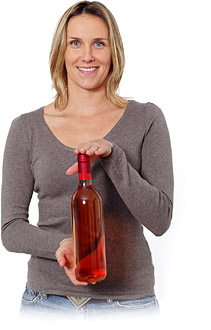 Dear Kraus:
Dear Kraus:
I am new at this wine making process. I am in the last stages and decided to take a small taste test even though I still have 2 or 3 days left in the last stage. It is terrible! Can the wine get better in that short period of time or is it to far gone and will not come out good?
Please Help, Gwen
—–
Hello Gwen,
It is completely normal for a wine to be harsh at bottling time. Even though the wine is about to go into bottles it does not mean that it is done becoming wine.
The wine will continue to evolve through aging or maturation. This simply means it will slowly change over time–in a good way– while it is in the wine bottle. Organic changes will slowly occur over the course of the next few months that will round off the harsh corners of the wine.
You can think of wine as a living thing. Even though it is done fermenting, clearing and in the bottle, it is still going through changes. Each wine ages differently. So how long your wine will take to become its best can only be a guess, but it is safe to say that after aging for 3-6 months you will notice a remarkable improvement. You may notice even marginal improvements up to 3 years, depending on the type of wine.
Best Wishes,
Customer Service at Adventures in Homebrewing
———————————————————————————————————
Ed Kraus is a 3rd generation home brewer/winemaker and has been an owner of E. C. Kraus since 1999. He has been helping individuals make better wine and beer for over 25 years.
What's Happening To My Wine?
 Hi,
Hi,
I crushed my grapes in late September & squeezed them. Then racked it 2 times since then. It’s been almost 2 months since the last racking and 1 of the 5 gallon wine carboys is starting to bubble again just slightly. What is happening should I do anything. The other 3 carboys are not doing this???
Thanks Rick
—–
Hello Rick,
It’s hard to know exactly what is going on with your forth carboy, but here are your possibilities:
1) Your wine has started to ferment again: This means that the original fermentation did not consume all the original sugars before it stopped. This is known as a stuck fermentation. You can verify this, or rule it out, by taking a reading with a gravity hydrometer.
If the reading on the specific gravity scale reads .998 or higher, then there are still some sugars to be fermented. Your best course of action would be to make sure the wine carboys are not too cold, at least 70F., and wait until all the sugars are fermented.
2) You added more sugar after the fermentation: If you added more sugar to sweeten the wine after the fermentation completed but did not add a wine stabilizer along with the sugar, you are in the same situation as before. The wine has started to ferment again. The only thing that you can really do at this point is to let the wine finish out the fermentation with the newly added sugars.
If you want a sweet wine, add sugar again, after the fermentation. Only this time also add Potassium Sorbate along with the sugar. This will inhibit the fermentation from restarting.
3) Your wine has become infected with a bacteria: This may be the case if you take a reading with a gravity hydrometer and it does not indicate that there are any sugars left in the wine carboy. This does not necessarily mean it is ruined, but it needs to be addressed.
Bacterial infection is something that normally happens when sulfites such as Campden Tablets or Potassium Metabisulfite are not used after the fermentation. In any event, the problem is easily rectified by adding a dose of either of these to destroy the bacteria.
Hope this helps you out.
Happy Wine Making,
Customer Service
———————————————————————————————————
Ed Kraus is a 3rd generation home brewer/winemaker and has been an owner of E. C. Kraus since 1999. He has been helping individuals make better wine and beer for over 25 years.
My Fermentation Has Too Much Sugar. What Should I Do?
 Oh OH, Mr.” wineproblemsolver”,I have a stuck ferment in my wild grape wine at 1.012. I tried adding a fresh yeast culture and yeast nutrient and it has not responded. My guess is I had the sugar to high. I was reading about 1.090 at the start but realized there was undissolved sugar in the bottom of the fermenter. I am not sure how much. The fermentation went well to SG 1.015 and then stalled. It went slowly down to 1.012 after the addition of the new culture then stuck tight. I might have a high alcohol problem? What do you think. Can I get it going again with a high tolerant alcohol yeast? What do you recommend? Dr. P
Oh OH, Mr.” wineproblemsolver”,I have a stuck ferment in my wild grape wine at 1.012. I tried adding a fresh yeast culture and yeast nutrient and it has not responded. My guess is I had the sugar to high. I was reading about 1.090 at the start but realized there was undissolved sugar in the bottom of the fermenter. I am not sure how much. The fermentation went well to SG 1.015 and then stalled. It went slowly down to 1.012 after the addition of the new culture then stuck tight. I might have a high alcohol problem? What do you think. Can I get it going again with a high tolerant alcohol yeast? What do you recommend? Dr. P—–
Hello Dr. P,
———————————————————————————————————
Ed Kraus is a 3rd generation home brewer/winemaker and has been an owner of E. C. Kraus since 1999. He has been helping individuals make better wine and beer for over 25 years.
I Need A Beginner Wine Making Kit For Dummies!
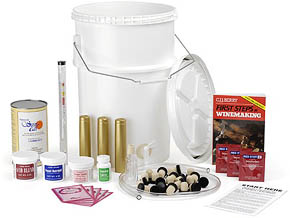 Hello Kraus:Is there a wine making kit for dummies that is both easy and cheaper than buying at the store (dry wine)?Thanks
Hello Kraus:Is there a wine making kit for dummies that is both easy and cheaper than buying at the store (dry wine)?Thanks———-
Hello Anthony,
The beginner Wine Making Kit is a simple, painless way to learn how to make your own wine. You can also give us a call any time you like if you have a question. We’ve been helping beginning home winemakers just like yourself for over 45 years now. We know how to guide you through the wine making process and get your first batch of wine brewing.
———————————————————————————————————
Ed Kraus is a 3rd generation home brewer/winemaker and has been an owner of E. C. Kraus since 1999. He has been helping individuals make better wine and beer for over 25 years.
Sediment In My Wine Bottles
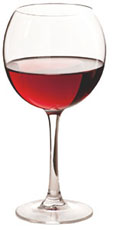 Hi
Hi
After I bottle my wines, I’m getting a small amount of sediment in the wine bottles after about a month. Talking to several people about this, they say I’ll probably always have this unless I start filtering my wine. I don’t make a lot of wine so it is hard to justify buying a pressure wine filtering system.
My question is how do coffee filters compare with the wine filters you sell with your pressure filtering system for effectiveness on removing sediment? Or is there something else I could try? I use a clearing agent and my wine usually sets about 5 months before I bottle it.
Thanks in advance for any information you can give me.
Bernie C.———-
Hello Bernie,
To answer your question, coffee filters do not compare to a pressurized wine filter. The typical coffee filter will filter down to somewhere around 20 microns. That’s about half the size of a human hair. A typical wine filter can filter down to a 1/2 micron. That is 40 times finer than the coffee filter.
How fine a wine filter can filter holds true regardless if you’re using our less elaborate Pressurized Wine Filter System or our more professional SuperJet wine filter system. The difference between the two is speed, not how well the are able to filter a wine.
A second area of concern with using a coffee filter is oxidation. If a wine is exposed to excessive air this can cause a browning and other oxidative effect on the wine. This is because when using a coffee filter to filter wine there is a lot of air exposure. This is do to the slow nature of filtering wine without pressure and the fact that the wine has to drip and splatter.
Now lets talk about the sediment in your wine and the most likely causes and solutions for this type of problem.
Your friends are completely wrong when suggesting that you will need to tolerate this sediment if you don’t filter. Filtering is never a necessity to a visually clear wine. In fact, wine filters are not designed to clear a cloudy looking wine, they are design to make a clear looking wine become more brilliant and polished in appearance. Attempting to filter a visibly cloudy wine will only clog the pads in a matter of a gallon or two of wine.
Sediment in the wine bottle is usually caused by one of two things: Either it is wine yeast is still settling out of the wine, and it just hasn’t had enough time to do so. Or, it could be a precipitation of some sort that is occurring after the wine has been bottled.
Precipitation means particle are developing out of thin air, so to speak… liquid in this case. Precipitation is most common when making a homemade grape wine.
In the first case the solution is simple: either speed up the dropping out of sediment with fining agents such as bentonite or Sparkolloid, or wait longer before you bottle. Wine yeast is as fine as flour so gravity can take some time to drag it to the bottom.
You stated that you let your wines set for around 5 months before bottling, so this is not likely to be the cause in your particular issue.
In the second case, things can be a little more tricky. When we say a precipitation of some sort is occurring in your wine, what we are really saying is your wine is unstable. Not unstable in the sense that it is still fermenting, but in the sense that change can potentially still occur in the wine.
The two most to common forms of precipitation in a wine comes from tannin proteins and excess acid. A temperature change of the wine can cause either to occur. If the wine becomes warmer than before tannin may drop out. If the wine becomes cooler than before acid may drop out. This is known as temperature stability, or the lack of, as the case may be.
Tannin will show up as a dusty, caked deposit. Acid will show up as salty or sugary looking crystals. There are tests and treatments you can do to a wine before bottling to make sure these deposits are kept in check.
To read more about stabilizing your wine you may want to take a look at the the article, Maintaining Temperature Stability In Your Wine, listed on our website. This article goes over how to do simple tests to determine if your wine has a temperature stability problem, and if so, how to go about resolving the issue.
I would like to point out at this time that if you are making a wine from homemade wine kits like our California Connoisseur, KenRidge Classic or any other brand, temperature stability is not your problem. All of these type of homemade wine kits, regardless of what brand you get or where you get it, have been stabilized for you ahead of time. So if you are getting deposits in the wine bottle with these wine kits you should suspect wine yeast deposits as the issue.
Happy Wine Making,
Customer Service
———————————————————————————————————
Ed Kraus is a 3rd generation home brewer/winemaker and has been an owner of E. C. Kraus since 1999. He has been helping individuals make better wine and beer for over 25 years.
My Wine Recipes Don’t Call For Any Water
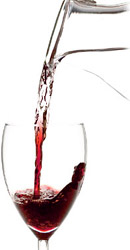 Hi,
Hi,
I have started with 32 lbs. of concord grapes, sorted and crushed. The recipe (doubled) on page 19 of your book named “Winemaker’s Recipe Handbook“, recipe #54, the Concord “Fresh -Dessert” one does not call for any water, where the other Concord choices of wine recipes do call for water.
As I have never made wine before that did not call for some water, what can I expect this wine to be like, dryish, or not, I am at a loss as to what to expect. Should I add some water?
Thanks
Kelly
———-
Hello Kelly,
Just to let you know, all the commercially made grape wines you see of the store shelf: Cabernet Sauvignon, Merlot, Chardonnay, Concord and hundreds of others, are made from 100% grape juice– no water added. The straight juice from these grapes are near optimal for making wine in terms of acidity, flavor intensity and sugar level. That’s why most wines are made from grapes.
But fruit wines such as raspberry, blackberry, plum, etc., all need to have their juice cut with water in their wine recipes. This is mainly because these juices have too much acid in them. This makes their flavor too sharp/sour for drinking. You can see some of these wine recipes on our website.
Using straight Concord grape juice when making a homemade grape wine will produce a full-bodied wine — rich in color with plenty of flavor. The other wine recipe with the water added, will make more of a blush wine, not as bold, more crisps in character.
It is important to note that one of theses wine recipes is not necessarily better than the other, they simply produce different styles of wine. Personal preference will dictate as to which one you think is best.
As to your question about the sweetness, either of these wine recipes can be made sweet or dry. How much water is, or isn’t, in these wine recipes does not factor into the sweetness. All the sugar in the wine must will be fermented into alcohol and the wine will by dry, regardless if water is used or not.
If you want your wine sweet it is just a matter of adding sugar at bottling time. It is also important to realize that if sugar is added you will also need to add potassium sorbate to stabilize the wine, otherwise a re-fermentation could occur.
Best Wishes,
Customer Service at E. C. Kraus
———————————————————————————————————
Ed Kraus is a 3rd generation home brewer/winemaker and has been an owner of E. C. Kraus since 1999. He has been helping individuals make better wine and beer for over 25 years.
Why Is My Wine So Bubbly?
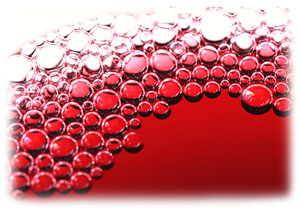 Hello:
Hello:
I’m getting ready to bottle my wine and noticed that it has a bubbly taste. Like champagne. Is this because I need to degas it? Or is there something else going on?
Ken
———-
Hello Ken,
It is very possible that you are correct in your assumption. The wine may simply need to be degassed. But you should also verify with a gravity hydrometer that the wine has actually completed its fermentation. It is possible that the bubbles you are experiencing are from a slight, but still active, fermentation.
When first learning how to make your own wine you want to get into the habit of double-checking that the fermentation has actually completed with a gravity hydrometer. Sometimes fermentation’s will stop before they are done.
If you do not know how to use a gravity hydrometer to check your wine, the article, Getting To Know Your Hydrometer, listed on our website, will give you an over view of the gravity hydrometer and its use.
If you have already determined that a slight fermentation is not the cause of your bubbly wine, then more than likely it is left-over, remnant CO2 gas from the fermentation. Putting the wine through a degassing process will be your answer.
There are a lot of ways to go about degassing a wine. You can siphon the wine back and forth between a couple of glass jugs in a splashing manner. Or, you can dump the wine back and forth between a couple of plastic fermenters. But both these methods introduce a lot of air into the wine. This is something you don’t want to do at this stage. It will promote the oxidation of your wine.
A safer way to go about it is to use a degassing paddle. A degassing paddle will agitate the wine without splashing it. This dramatically reduces the effects of oxidation. It attaches to a power drill, just like a drill bit, so it takes very little effort to use. The paddle blades also fold up so that they will fit into the small opening of a wine carboy.
Happy Wine Making
Customer Service at E. C. Kraus
———————————————————————————————————
Ed Kraus is a 3rd generation home brewer/winemaker and has been an owner of E. C. Kraus since 1999. He has been helping individuals make better wine and beer for over 25 years.
Should I Use The Juice Or The Pulp?
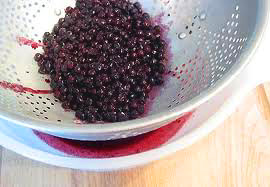
Hello-
I’ve never made wine; but, I’m slowly acquiring the wine making materials. I would like to make fruit wines mostly plum and perhaps strawberry and peach.
From what I’ve been reading it seems that either one starts with juice and does the whole fermentation process that way or that one ferments the chopped up raw fruit contained in a bag for a week or so and then continues the fermentation process in a different container less the pulp.
My question is: Will the wine be better tasting if one ferments the pulp of raw fruit or will it be better tasting if one extracts the juice of the raw fruit first presumably by cooking with a and straining or by using a steam juicer?
Thank you.
Joe
———-
Hello Joe,
When making wine with your own fruit, to achieve optimal flavor, color and body, we recommend fermenting with the pulp and skin. This is what provides most of the color and body. You can use a steam juicer to extract the juice, but you should still keep the pulp in with the fermentation for the first 5 to 7 days.
The only argument for leaving the skin and pulp out of the fermentation would be if you are trying to achieve a light-bodied wine. An example of this would be apple wine.
This is no different than how professional wineries approach making wine. In general, with red grapes they run them through the grape crusher then ferment them before running them through the grape presses. With white grapes, they crush and press before fermenting.
Best Wishes,
Customer Service at Adventures in Homebrewing
———————————————————————————————————
Ed Kraus is a 3rd generation home brewer/winemaker and has been an owner of E. C. Kraus since 1999. He has been helping individuals make better wine and beer for over 25 years.
Does Freezing The Fruit Wipe Out The Funk?
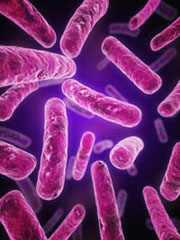 Quick question,
Quick question,
If you have frozen fruit (like I do) for months do you need to use Sodium Metabisulfite when you start the wine brewing process or does the freezing kill all the bad stuff.
Thanks,
Steven
———-
Hello Steven,
Unfortunately, freezing does not destroy mold, bacteria or other “bad stuff”. It simply puts its growth into suspension, or hibernation if you like. Freezing will damage some of the cells with freezer-burn, but not nearly enough to save your fruit from needing a sulfite treatment of some kind. You will still need to add sodium metabisulfite before using it to make wine.
Even though freezing does not eliminate potential spoilage, it does temporally stop the spoilage process. This is great for someone trying to save up enough grapes to make some homemade grape wine.
Often in a small backyard vineyard, the grapes will not ripen evenly throughout the rows. In this situation you can freeze what ripens early until you have enough saved to make a batch of wine. Just realize that you will still need to add sodium metabisulfite to the batch before fermentation and again, before bottling, regardless if the grapes have been frozen or not.
I hope this answers your question. Nothing wrong with freezing fruit. It just doesn’t eliminate the need for sulfites.
Best Wishes,
Customer Service
———————————————————————————————————
Ed Kraus is a 3rd generation home brewer/winemaker and has been an owner of E. C. Kraus since 1999. He has been helping individuals make better wine and beer for over 25 years.
